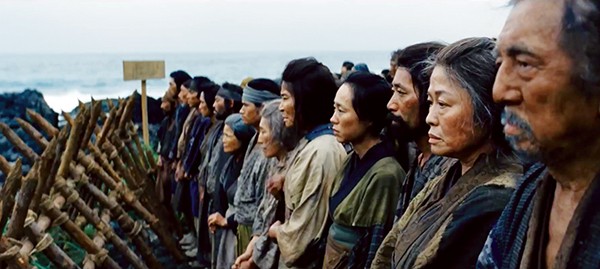If God is good, and everything he does is good, then why is man doomed to a lifetime of suffering? That’s a problem that has bedeviled every philosopher since Plato put stylus to goatskin. All religions must address it at some point, even if it is just to wave it away. It’s also the central question around which Martin Scorsese built his epic, Silence.
It’s 1633, and the age of colonialism is in full swing. Jesuit missionaries, Sebastião Rodrigues (Andrew Garfield) and Francisco Garupe (Adam Driver), find out that their mentor, Cristóvão Ferreria (Liam Neeson), has gone missing in Nagasaki, Japan, amidst a crackdown by the shogunate on the country’s small but fervent Christian population. Worse still, the last word on Ferreria was that he had denounced Christianity before meeting his uncertain fate. Rodrigues and Garupe can’t believe that and ask permission to sneak into Japan and clear their teacher’s name. Reluctantly, their superiors agree, and they book passage with smugglers from Macau to Japan. Their guide, the only Japanese person they can find, is a drunken lout named Kichijiro (Yôsuke Kubozuka), who takes them to a tiny fishing village on the Japanese coast. There, they find a population terrified by the Inquisitor Inoue Masashige (Issei Ogata), a ruthless hunter of Christians.

Jesuits have a reputation as something like Christian ninjas, so laying low in the neighborhood priest hole is no big deal for Rodrigues and Garupe. As word spreads through the Christian underground, Rodrigues, whose internal monologue provides the narration for the early part of Silence, finds himself amazed at the hardscrabble faith of the downtrodden fisher people who brave the shogun’s patrols to come to confession. When he sneaks off to a neighboring village, he converts hundreds of souls. Maybe the difficulties of Japan have been overstated, he thinks, and his simple faith will be enough to save a country.
He is completely wrong. The Inquistor’s men catch wind of the presence of the priests and descend on the village, forcing Rodrigues and Garupe to flee as the villagers sacrifice themselves on their behalf. Watching three villagers suffer for days as they are crucified in the ocean is just the first of the unimaginable spiritual and physical torments that await the priests, and the audience, as the 161-minute film rolls on.
There is much to admire about Silence. In his skill as an image composer, Scorsese has few, if any, peers. Working again with The Wolf of Wall Street cinematographer, Rodrigo Prieto, he creates one stunning tableau after another, beginning with the opening sequence in a misty hot spring that recalls Kurosawa’s “Mt. Fuji in Red” segment from Dreams. Garfield, only two years removed from hanging up his Spider-Man tights, gives it all in the portrayal of a priest whose worldview slowly crumbles around him. Driver is, as usual, fantastically physical. In one breathtaking long shot on a beach, an emaciated and filthy Driver towers over his captors, communicating his fear and defiance with only his gait. Ogata, a Japanese comedian, is a revelation as the surprisingly hospitable Inquisitor. And it’s good to see Neeson getting some meaty roles to chew on where he doesn’t have to rescue any kidnapped girls.
Scorsese has been trying to get this film through development since 1990. In the ensuing decades, he seems to have identified a little too strongly with his protagonists. Silence doesn’t so much question suffering as wallow around in it. The priests’ mission is difficult, but frankly, they don’t seem to be very good at their jobs. Instead of bringing peace to their flock, they bring only misery, and their famed Jesuit spy craft leaves much to be desired, as they are are easily flushed out by the authorities’ superior knowledge of the land and culture. When Rodrigues is being ferried in secret to a village by a grumpy boat captain, he has a moment of clarity: “I’m just a foreigner bringing trouble to these people.” Indeed, when he reaches his destination, it has already been destroyed by troops looking for him.
Scorsese has been in these theological waters before, helming the vastly superior The Last Temptation of Christ. Garfield is good, but he’s no Willem Dafoe. The controversial 1988 film found transcendence in the material world, while the message of Silence seems to be “Suffering sucks. Get used to it.”